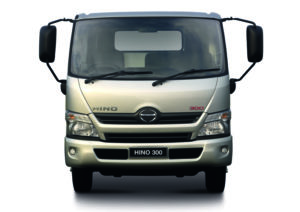There are two 4009cc-capacity Hino engine derivatives in the all-new Hino 300 Series –– a normal aspirated (Euro 1) unit producing 73 kW (99 Hp) @ 3,200 rpm and torque of 252 Nm @ 2,000 rpm, plus a turbo-intercooled (Euro 2) engine producing 86 kW (125 Hp) @ 2,500 rpm with torque at 353 Nm @ 1,800 rpm. The turbo-intercooled Hino engine is particularly suited to long distance work with big variations in altitude where turbo-charging provides consistent power at any height above sea-level. Fuel economy remains a key issue in the overall design of these new 300 Series as Hino engines deliver high torque at low rpm for good fuel consumption.
All new Hino Series are equipped with fuel-efficient, low friction-loss, hypoid-design rear axles. Rear axle gear ratios have been chosen to match the transmissions and provide optimum cruising speeds that match African road conditions and gradients while complying with the speed limits of every country.
Radial-ply tyres are standard for the range based on 16 inch rims – ply rating depends on the GVM of each model and its carry capacity. Radial tyres add to improved fuel economy through lower rolling resistance and longer tyre life resulting from cooler running properties.
Hino’s all-steel suspension is particularly suited to African conditions where the rear axle leaf-springs incorporate additional helper-springs for maximum load and stability at the rear. An unusual feature is a small wear pad situated on the helper-spring over-ride bracket to prevent spring-pack wear and allow for rapid replacement of the wear pad instead of a spring blade repair. Both front and rear axles are equipped with shock absorbers and stabiliser bar on the front axle to increase steer-ability and road holding.
Cargo-body length is dependent on wheelbase which ranges from 2,525m on the 3500kg GVM base model up to 4,2m on the 8500kg GVM range topping model 913. Every new 300 Series Hino has a 6mm thick chassis frame specially chosen for operation in Africa. Custom-built cargo bodies will suit any product transported.
A standard forward-control, tilt cab comfortably seats three adults including the driver. The forward control cab design permits maximum body space on each wheelbase and provides drivers with maximum and excellent forward view of the road for safety and in heavy traffic conditions in cities. A significant advantage of a tilt-cab design is access to all major components for maintenance and servicing to limit in-service downtime. The cab floor pan benefits from increased use of galvanised steel, ensuring excellent durability and a lasting appearance. An additional amount of rust proofing has been applied to other areas, providing even further protection against corrosion.
The reinforced cab has been designed to protect occupants in a front or side collision situation and to ensure the cab has the durability and integrity needed to endure years of heavy use. The cab structure is designed to minimise the effects of an accident with protective side-beams mounted inside each door panel. A seat-belt is fitted for each person in the cab.
The previous Hino 300 Series model was sold on world markets for 12 years. Hino’s all new 300 Series marks a major step forward in Hino design philosophy. African road transport users will appreciate the advantages that these new trucks offer.








